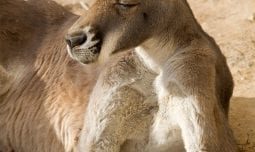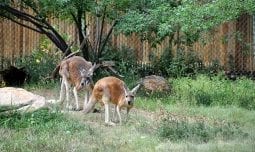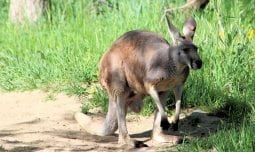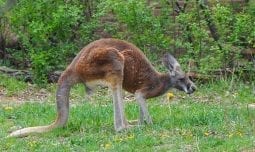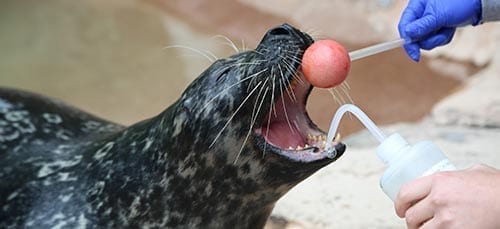Classification
Class Mammalia
Order Diprotodontia
Family Macropodidae
Genus Megaleia
Species rufa
Habitat & Range
The open plains, scrubland, grassland and desert of central Australia.

Red Kangaroo
Megaleia rufa
Kangaroos cannot walk forward or backward. They must jump or hop to move around. They have powerful Z-shaped hind legs to propel them and a large tail used for balance when sitting or moving. They sometimes use a five-legged gait where the forelimbs and tail balance the animal as the hind legs are moved forward. Kangaroos are the only bipedal marsupial that moves on two legs instead of all four.
Adaptations
Marsupial Pouch
Kangaroos are marsupials or pouched mammals. Females give live birth very early in the embryonic development phase and the extremely immature newborn must crawl up the mother’s fur and into the pouch where it is protected as it continues to nurse and completely develop.
Whew It’s Hot
Kangaroos have several adaptations for living in the Australian heat. They sweat while moving and pant when exercise stops. In addition they have a dense network of blood vessels near the surface of the skin on their forearms. They lick their forearms which allows the wind to blow heat away from the warm blood. They spend the hottest part of the day sleeping or resting and graze at night or early morning when it is cooler.
Hop Along
Kangaroos cannot walk forward or backward. They must jump or hop to move around. They have powerful Z-shaped hind legs to propel them and a large tail used for balance when sitting or moving. They sometimes use a five-legged gait where the forelimbs and tail balance the animal as the hind legs are moved forward. Kangaroos are the only bipedal marsupial that moves on two legs instead of all four.
Physical Description
- Male red kangaroos stand about six feet (1.8 m) tall and females are smaller standing about three and a half feet (1.1 m) tall
- Males weigh up to 175 pounds (80 kg), and females seldom weighing more than 75 pounds (34 kg).
- Males have red-brown fur while females are more blue-gray in color.
- Kangaroos have powerful Z-shaped hind legs and a strong tail used to help balance the body as they hop.
- They have shortened upper limbs with clawed paws.
- They have a narrow head, long nose and long pointed ears.
- Females have a forward facing pouch and four nipples.
Diet
What Does It Eat?
In the wild: Grasses, leaves, roots and low, herbaceous plants.
At the zoo: Hay, grain and vegetables as well as vitamin and mineral supplements.
What Eats It?
Red kangaroo are large, and because of their strong legs and clawed feet keep most predators away. Dingos do prey on kangaroos, and the young may be captured by raptors. Humans also eat red kangaroo.
Social Organization
Red kangaroos live in small groups of ten or less but come together in larger groups when food or water is scarce. A group of kangaroos called a “mob” consists mostly of females with their offspring and one or two males. Red kangaroo are mostly nocturnal and rest in the shade during the day.
Life Cycle
Female kangaroos reach maturity at 15-20 months, and males at 20-24 months. Red kangaroos can breed year round when seasonal conditions are favorable, and males will compete for mating opportunities with several females. Red kangaroos have a shortened gestation period and the young are born only 33 days after mating. The young kangaroos called joeys are born in a very immature state, averaging only one inch (2.5 cm) long, and weighing 0.035 ounces (less than one gram!). After birth the tiny newborn crawls up the mother’s fur into her pouch and immediately attaches itself to a nipple. The joey stays permanently attached to the nipple for about 70 days suckling and continuing to develop. Females nurse their young for about a year, carrying them in the pouch for the first eight months. Females may have one joey in the pouch, an older joey outside the pouch but still nursing, and a blastocyst awaiting implantation. Males do not assist in raising the young. Female kangaroos stay with their natal group but males leave when they reach maturity. Red kangaroo live up to 22 years in the wild.
Fun Facts
- The red kangaroo is the largest of all kangaroos and the largest living marsupial.
- When male kangaroos fighting to establish breeding rights, they appear to be “boxing” with their front limbs.
- Males are called “Boomers” and females are known as “Blue Flyers”.
- Baby kangaroos are the size of a lima bean, or gummy bear, when they are born.
Conservation Status
IUCN Status: Lower Risk, Least Concern
Red kangaroos are not threatened or endangered at this time. They are considered a nuisance animal in Australia because they damage fences, compete with livestock for grass and water, cause erosion and pose a hazard to drivers. Australia has a wildlife management program for culling of kangaroos. Throughout time, Australian aboriginal peoples have used kangaroos as a source of meat and hides. They are a sacred animal in the Aboriginal culture and appear frequently in Aboriginal art and stories.

Download the App!
Get the FREE Denver Zoo app today, and be a pro the next time you visit the Zoo. You’ll get access to the Zoo map, daily activities and schedules, animal facts, and more. You can even load your membership card onto the app for additional convenience. It puts everything you need for an amazing Zoo experience right into the palm of your hand!
